I get this question fairly often: What’s the difference between Szechuan and Hunan cuisine? They’re both from China and they’re both hot and spicy. So, what’s to choose between them? Turns out, quite a lot! Therefore, we hereby offer our Field Guide to China’s most exotic cuisines…
 Szechuan Curried Chicken – with Dried Red Chilies, Peanuts and slivered Scallions.
Szechuan Curried Chicken – with Dried Red Chilies, Peanuts and slivered Scallions.
Note the bright, red colour of the Sauce…
Where?
Szechuan Province is in southwest China and was one of the first places visited by western travelers (i.e.- Marco Polo, et al). No surprise that Szechuan region was one of the first parts of China to taste Western foods, including Beans, Sesame Seeds, Potatoes, Maize (Sweet Corn) and Walnuts. They grow lots of rice in Szechuan but also like their noodles.
 Hunan Cured Ham with Yard-Long Beans and Fresh Red Chilies.
Hunan Cured Ham with Yard-Long Beans and Fresh Red Chilies.
Note the rich, dark colour of the Sauce…
Hunan province is located east of Szechuan, in south-central China. It, too, has a rich and diverse agricultural tradition and its trademark cuisine has embraced the styles of many smaller areas in the region. Hunan cuisine is set aside from the other Seven Great Traditions of Chinese Cooking by its liberal use of spices, its fresh aromas and its rich, dark colours.
What?
The Szechuan Peppercorn – which, along with Garlic, forms the backbone of Szechuan flavour profiles – have always grown there, but this iconic zinger is now accompanied in the region’s markets by a host of Chilis, which may have come by way of India and which are almost always used dried. Szechuan menus also include a fair selection of non-spicy dishes to help cool the palate, not unlike Indian menus which feature fresh fruit and vegetable Salads and sauces like Raita, based on Cucumber and Yoghurt.
Hunan flavours are hallmarked by Hot Peppers, Shallots and Garlic. They also make liberal use of vegetales, notably the famous Chinese Yard-Long Beans and other fresh ingredients particularly identified with the region. Hunan cookery includes a tradition of pickling, smoking and curing, which Szechuan cuisine lacks. Again, both Noodles and Rice are served.
How?
As we said… Szechuan relies more on dried ingredients for its flavourings while Hunan uses more fresh ingredients. Hunan has no real equivalent of the numbingly-hot Szechuan Peppercorn. Szechuan cuisine tends to be more piquant, brighter and lighter in flavour while Hunan is deeper and more celebratory of the umami sense than Szechuan.
While Szechuan cooking is generally Wok-centric in its techniques, Hunan embraces the pickling jar (not unlike the Korean Kimchi tradition) and the grill as well stewing, braising, pot roasting and pan frying. Where Szechuan cuisine stays a pretty firm course season to season, Hunan cookery has definite seasonal style changes, going with fresh ingredients when they are in season. That means meals consisting of cured meats and vegetables served cold with pickles and fresh chilies in summer and dishes such as the famous Hunan Hot Pot, using preserved and dried ingredients in Winter.
Got it? Okay… Now go and try it!
~ Maggie J.

